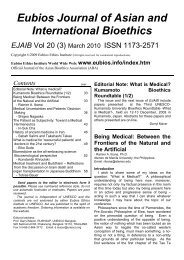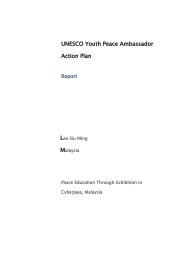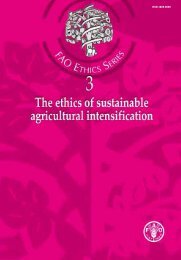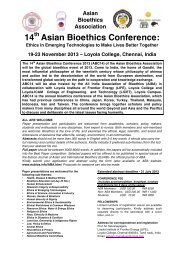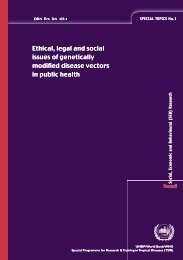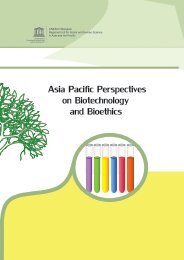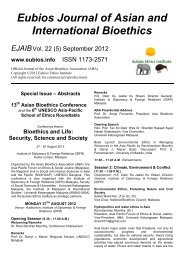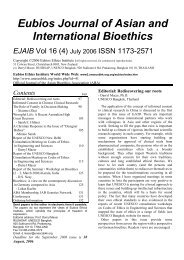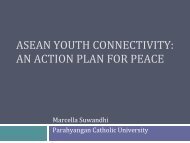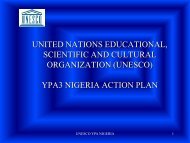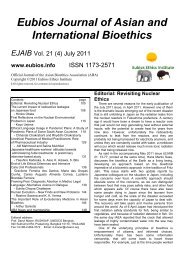Eubios Journal of Asian and International Bioethics EJAIB
Eubios Journal of Asian and International Bioethics EJAIB
Eubios Journal of Asian and International Bioethics EJAIB
- No tags were found...
Create successful ePaper yourself
Turn your PDF publications into a flip-book with our unique Google optimized e-Paper software.
<strong>Eubios</strong> <strong>Journal</strong> <strong>of</strong> <strong>Asian</strong> <strong>and</strong> <strong>International</strong> <strong>Bioethics</strong> 18 (January 2008) 9chemical fertilizer <strong>and</strong> water. The ratio <strong>of</strong> energy input toprotein output under such a system was poor. Animal proteinwas only 1.4 more nutritious for humans than a comparableamount <strong>of</strong> plant protein, yet consumed 11 times more fossilfuels. Further, feed ingredients were varied <strong>and</strong> included suchitems as dying <strong>and</strong> diseased animals, fecal material fromother factory farmed animals, blood, feathers <strong>and</strong> hair, <strong>and</strong>plastics, which had already led to health scares such asbovine spongiform encephalopathy (‘mad cow disease’). DrKanaly argued that as world per capita incomes <strong>and</strong> rates <strong>of</strong>urbanization grow, the true costs <strong>of</strong> cheap meat <strong>and</strong> theethics <strong>of</strong> this sort <strong>of</strong> food production need to be seriouslyexamined, since both translate into an increased dem<strong>and</strong> foranimal products.Pr<strong>of</strong> Abhik Gupta noted that energy subsidies for all kinds<strong>of</strong> food, even vegetables, were enormous in some countries,<strong>and</strong> mentioned the trend <strong>of</strong> ‘cage-free’ or ‘free-range’ meat inthe US. Dr Kanaly agreed that it was a small movement, atleast in some parts <strong>of</strong> the US, but as consumers grew moreaware <strong>of</strong> livestock conditions producers were potentiallychanging their public face rather than actual practices. Hecited an example <strong>of</strong> an egg farm in South Carolina owned byCatholic monks who used imagery <strong>of</strong> care to sell their eggseven though the operation was basically a factory farm. It wasvery difficult for consumers to get accurate information aboutthe sources <strong>of</strong> their food <strong>and</strong> how animals are treatedbecause the industry was very reluctant to divulge it.Pr<strong>of</strong> Abhik Gupta from India presented a paper on theneed for application <strong>of</strong> the precautionary principle withregards to the mass cultivation <strong>of</strong> biodiesel-yielding plants inbiodiversity-rich areas. Being biodegradable <strong>and</strong> nonpolluting,increasing use <strong>of</strong> biodiesel was expected to reducecarbon dioxide emissions <strong>and</strong> was seen by many as a ‘winwinproposition’ towards meeting the energy requirements<strong>and</strong> providing livelihood opportunities in the denselypopulated <strong>Asian</strong> countries. Pr<strong>of</strong> Gupta argued, however, thathasty <strong>and</strong> indiscriminate plantation <strong>of</strong> biodiesel-yielding plantsin Asia, especially in its biodiversity-rich areas, was fraughtwith environmental <strong>and</strong> ethical concerns. In his home country<strong>of</strong> India, the biodiesel crop jatropha was being aggressivelypromoted by government <strong>and</strong> industry for an area in theNorth-East recognized as a Biodiversity Hot Spot, <strong>and</strong> inMalaysia <strong>and</strong> Indonesia, oil palm plantations were usurpingtropical forests. Features such as invasive potential, toxicity,<strong>and</strong> effects on water <strong>and</strong> soil content were not being fullyassessed in bi<strong>of</strong>uel proposals. Pr<strong>of</strong> Gupta suggested thatbi<strong>of</strong>uels be made one <strong>of</strong> the foci <strong>of</strong> the project, <strong>and</strong> thatparticipants or partners could consider building a database onthe different facets <strong>of</strong> bi<strong>of</strong>uels, especially biodiesels, in orderto be able to make an informed assessment.Pr<strong>of</strong> Gupta was asked about the need for high usage <strong>of</strong>fertilizers on bi<strong>of</strong>uel crops, given that there had beenproblems with the soil for Indian jatropha plantations. Heagreed this was a problem, mentioning a study done by the<strong>International</strong> Crops Research Institute for the Semi-AridTropics (ICRISAT) in India which found that jatropha plantedon marginal l<strong>and</strong> will grow, but without fertilizer <strong>and</strong> labourintensivecanopy management it will not produce seeds,which are the valuable part <strong>of</strong> the crop. He questionedwhether farmers would be able to meet these conditions orwhether jatropha might lead to further l<strong>and</strong> degradation <strong>and</strong>rural indebtedness. Dr N. Manohar wondered if jatropha mightrepresent a similar scenario to the planting <strong>of</strong> eucalyptus inIndia in the 1960s <strong>and</strong> 70s, which had negative environmentalimpacts because it lowered the water table. Were there, heasked, site-specific environmental impact assessments donein planning jatropha plantations? Regarding the toxicity <strong>of</strong>jatropha, he remembered it being used during his childhooddays as fencing material, as cattle never grazed it <strong>and</strong> peoplenever touched it. Pr<strong>of</strong> Gupta agreed that eucalyptus wasdamaging, <strong>and</strong> that site-specific assessments were needed toavoid a similar dem<strong>and</strong> on underground water resources byjatropha, as was already happening with jatropha in otherparts <strong>of</strong> the world. Huge monocultures would always bringecological problems, <strong>and</strong> he felt it essential that legal limits beplaced on any kind <strong>of</strong> monoculture. There also needed to beawareness campaigns, particularly for farmers.An additional comment came from Ms TanujaBhattacharajee on consideration <strong>of</strong> the issue <strong>of</strong> food securityas a consequence <strong>of</strong> energy crop plantations. The export <strong>of</strong>bi<strong>of</strong>uel may result in the import <strong>of</strong> food which could have asevere impact at the national level, particularly in countriesthat are poor such as Bangladesh or Myanmar. She felt,therefore, that it was not a global solution to encourage orcompel bi<strong>of</strong>uel plantation without analyzing the long-termsocio-economic benefit.These papers were followed by the first working groupsessions <strong>of</strong> the meeting.The final day <strong>of</strong> the conference, 28 September, beganwith the session on Energy independence <strong>and</strong> security. DrSalil Sen <strong>of</strong> Thail<strong>and</strong> spoke on ‘Green advertising: Greensupply chain - CSR driven retailing <strong>and</strong> logistics’. Theconfiguration <strong>and</strong> context <strong>of</strong> business at the global level wastransforming, with a growing need for sustainability coupledwith growth. Intensified competition, consumer expectations,<strong>and</strong> the natural resource crunch were driving corporateleadership to synthesize their corporate social responsibilitieswith corporate strategies. There were some tensions,however, between the imperatives for developing renewable<strong>and</strong> bi<strong>of</strong>uel resources, <strong>and</strong> the imperatives for advertising <strong>and</strong>promoting high energy consumption luxury products.Pr<strong>of</strong> On-Kwok Lai asked how Dr Sen saw the future forcommunications in terms <strong>of</strong> green messages, in how theproducts related to the user <strong>and</strong> producer, which both affectthe extent <strong>of</strong> the environmental problem. Dr Sen replied thatthe product was taking a back seat now <strong>and</strong> it was serviceswhich were emerging. People were concerned about theirown health, about societal health <strong>and</strong> about the sustainability<strong>of</strong> our planet.Dr Jasdev Singh Rai from the United Kingdom spoke on‘Concepts <strong>of</strong> communities, energy security <strong>and</strong>independence’. He outlined three essential concepts thatdefine the relationships between communities, energy <strong>and</strong>their environment: anthropocentric systems which hold thathuman beings are at the centre <strong>of</strong> God’s design (Abrahamiccultures); ecocentric systems which hold that human beingsare only one life form in the universe (Eastern <strong>and</strong> otherphilosophies); <strong>and</strong> post-enlightenment scientific systems withconfidence in human reason to solve every possible problem(modernity). States <strong>and</strong> communities <strong>of</strong>ten view energy fromdifferent perspectives – the state from the rational <strong>and</strong> thecommunity from other views rooted in past traditions. Energysecurity <strong>and</strong> energy independence were sources <strong>of</strong> increasingconflict in the international community, for example, in thecase <strong>of</strong> Iran. Dr Rai suggested that there was a need toextend the m<strong>and</strong>ate <strong>of</strong> the <strong>International</strong> Energy Agency togive it a greater role in setting up secure energy resourcesupplies between countries. There could be internationalsupervision, or even international ownership <strong>of</strong>, nuclear powerplants <strong>and</strong> nuclear technologies. Plural outlooks would bestengage marginalised communities. The internationalcommunity should move away from universal conventions<strong>and</strong> declarations to multiple systems which are rooted inregional cultures.Dr Ayoub Aby-Dayyeh took issue with some comments <strong>of</strong>Dr Rai about the history <strong>of</strong> the relationship between Islam <strong>and</strong>science, which Dr Rai later clarified. He was also critical <strong>of</strong> DrRai’s questioning <strong>of</strong> our commitment to prolong the humanlifespan at all costs. He felt that population growth, rather thanlengthening the life <strong>of</strong> human beings, was the waste <strong>of</strong>energy. Dr Rai suggested that longer lives <strong>and</strong> increased



